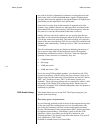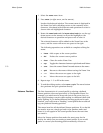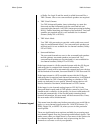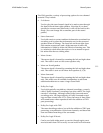
5-17
Nº40 Media Console Menu System
speaker over another, adjust the output levels of each speaker in
turn to 75 dB SPL (C-weighted, slow). (The Nº40 will automatically
generate appropriate test signals when you move into the section of
the menu in which you can adjust output levels.)
When adjusting the subwoofer level, be sure to move the meter
back and forth around the listening position by at least a foot or
more (or about a half-meter) to average out the local effects of room
modes (standing waves). Doing so will give you a more accurate
measurement of the real subwoofer output in the listening area.
Boundary gain compensation
If your listening position results in most of the listeners being close
to the rear wall, the resulting bass level can be sufficiently rein-
forced by the boundary that the overall sound quality becomes
boomy. If this is the case for this particular listening position, turn
BCG on. If not, leave it off.
Disable this position
Four listening positions are more than you will probably need. This
option allows you to disable any unused listening positions so that
they do not show up in any lists or menus. Listening position one
cannot be disabled.
Bass Peak Limit
The last item in the speakers setup menu is a bass peak limit
control. This menu item establishes a maximum volume setting for
the subwoofer output, and is provided as a safety measure against
the possibility of overdriving your subwoofer into destruction.
Some powered subwoofers have built-in protection against over-
load, or have amplifiers designed to be incapable of destroying the
subwoofer driver itself. If your system employs this sort of protec-
tion, leave the bass peak limit at its maximum (and therefore
effectively disabled) setting. After all, the speaker designer knows
the limitations of his/her product better than either you or we can.
It is best to let the speaker designer decide.
However, many subwoofers lack any protection against being over-
driven, other than your own discretion in using the volume
control. While this discretion is always a good thing – if your
system starts to sound distorted, “fuzzy” or garbled at high
volumes, turn it down! – some people might prefer to have the
system itself provide a measure of additional protection. This task
falls to the bass peak limit item of the speaker menu.
In discrete multichannel digital audio, it is possible to have six (or
more) channels of information that contain deep bass information.
In many cases, the only speaker in the system that can reproduce
deep bass is a single subwoofer. If one subwoofer is expected to do
the work of six speakers, and the listener-controlled volume is


















